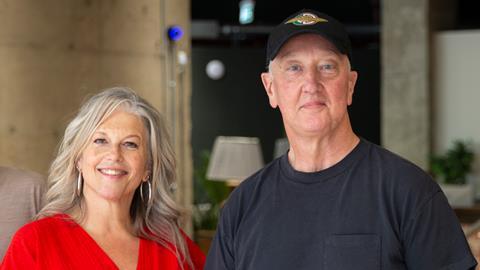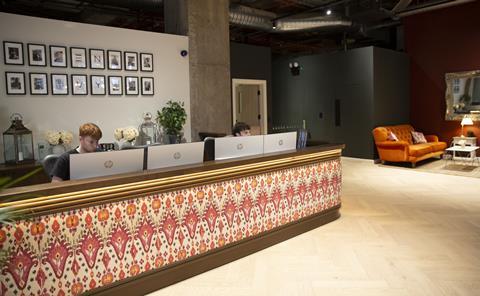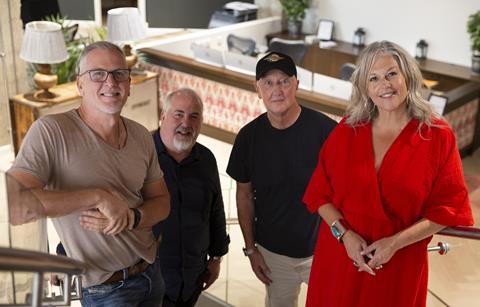Broadcast Tech sits down with Envy founders Dave and Natascha Cadle in the post-production giant’s latest building

Envy has opened an office at 1 Stephen Street, London, in what was previously Fremantle Media’s Stephen Street studios.
The post-production facility replaces Envy’s former London HQ (and original Envy building) on Rathbone Place, as well as Envy’s Holden House building, which was in the same block as Rathbone Place.
The new Envy building is on a vast scale (25,000 sq ft), adding 28 offline rooms, five online suites, five grading suites and eight audio studios, plus client areas and offices, generous production areas and a bar.

Broadcast Tech caught up with Envy founders Dave Cadle and Natascha Cadle for a tour of the new building and a chat through the move.
Dave Cadle, CEO, Envy, said: “We always knew we were going to be told to leave Rathbone at some point [the building is being knocked down and rebuilt] so we’ve been looking at this place for a while. Rathbone was pretty spectacular, but we knew we had to do something even better than Rathbone. When you walk into Stephen Street now it’s got presence – our clients come in with their clients from Apple or Netflix and you want them to go, ‘Oh, okay, this is a great place.’

“When we got into Stephen Street, the first thing we did was redesign the space and put Mezzanine areas in, which added nearly 7,000 square feet of space. That extra space is almost free real estate – we’re paying business rates on it, but it made the whole footprint a lot more acceptable to build.”
The opening of Stephen Street comes shortly after Envy acquired fellow post houses, Halo and Evolutions, hugely expanding Envy’s real estate and reach.
As Dave Cadle explains: “Halo do drama, which we want to get more involved in, and this drama could feed [Envy-owned commercials-focused post/VFX house] Absolute’s film visual effects side of things. We wanted to expand the Envy group, and we want to utilise Halo’s skills.
“There’s a lot of rooms at Halo, so we’re going to do something with it and make it work. I think next year looks like it could be busier than the last couple of years, so hopefully if we’ve got this right, we should see that up curve and we’ll have the resources to cater for it.”
The initial talks that led to the acquisition of Halo and Evolutions came shortly after Halo themselves had acquired Evolutions, through investment from Australia-based Morris Group. Months after this deal was made, Dave Cadle and Halo’s CEO John Rogerson got together to talk about the future for Halo and for Envy, and whether there might be a future in which the brands joined forces.
“We got around a table and talked. From our point of view, we knew that even with the Stephen Street building, we would need more space. We went to see the Evolutions building and thought it would be a great fit for us – that’s what tipped the deal over.”

PICTURED ABOVE (Left to right): John Rogerson, CEO, Halo; Alan Jones, founder, Halo; Dave Cadle, CEO/founder, Envy Group; Natascha Cadle, creative director/founder, Envy Group
“Apparently when Evolutions created its HQ on Sheraton Street, its remit was to make it look like Envy,” said Cadle.
Now the building is part of Envy it will soon begin transitioning from the Evolutions branding to Envy. “While the building still needs some updates, we can reorganise a few areas and make some additions. With a few changes, it will hopefully feel like a natural part of Envy,” says Dave Cadle.
Meanwhile, for Halo, things will largely stay the same following the acquisition. “Halo has a good feel to it – you walk around and go, it’s scruffily okay,” says Dave Cadle. “They’ve got a set of clients that like working there and I don’t want to disrupt it. We just need to change it a little bit and make it a bit smarter, so we’re going to spend some money on that.”
As a recap, this is what Envy group now looks like – there are Envy buildings at Stephen Street (offline and picture and audio finishing), Windmill Street (a predominantly offline house with 28 rooms) and Foley Street (another offline house, with a further 78 offlines).
Added to this, Envy has a building on Mortimer Street where its commercials/short-form brand Absolute is based, as well as a base in London Bridge, where on-location services department Capture is based.
Through its acquisition of Halo, it now also has the former Evolutions building on Sheraton Street (a large scale, full service facility). Meanwhile, Halo’s post-production facilities are on Noel Street.
This extensive real-estate includes a plethora of offline rooms, which for years have been seen as almost loss leaders to bring clients in for the much more lucrative finishing work.
However, there have been moves by streamers and large production companies to look at taking control of the offline edit and storage of rushes themselves and limit their use of post houses to just the finishing work.
If this shift in client needs begins to take place across the production sector, where does this leave Envy with its sizeable focus on offline?
Dave Cadle says he’s realistic about the evolving needs of clients and is prepared to act accordingly if this means a pivot away from offline. “If that’s the way it’s going to be, it’s going to be that way.”
“But I don’t think offline is going to be completely dead for certain clients, even if the big four or five could say no, it’s coming to us. We’ll look at it and evaluate it. The leanest part of the business is the offline, and the real value is in the finishing. We’ve always pushed the creative talent as the real reason to be here.”
Currently, though, the demand for offline is as strong as it’s ever been. As an example, Dave Cadle says: “Traitors next year alone will need more rooms than most facilities’ offline capabilities could cope with.”
Talking more broadly about the business of running a post-production house in 2025, Natascha Cadle adds: “Rates have not gone up in 25 years, and the costs have and I don’t quite understand the logic. I don’t know a single business that’s been able to say, yeah, we charged the same 25 years ago. You’re making money to invest and become the best. And the best staff costs, the best location costs, the best everything costs.”
Dave Cadle echoes this: “When you break the business down and you talk to someone in a normal business, they go ******.
He points to the acquisition of The Farm Group by American post-production giant Streamland Media a few years ago as an example of how things can quicky spiral out of control. “I don’t know what the mindset was for the Americans buying The Farm for a lot of money and then spending a short duration in town before saying, get us out of here,” he said. “Look at that as a business plan – it’s like, where did it really go wrong? From the minute you acquired it.”
He pauses for a second before adding: “It is a really tough business. But we’ve shown that you can make money in post-production, you can invest and you can keep going and keep getting stronger.”





No comments yet